italy
 I have never been caught up in a serious earthquake, and I don’t think I want to, but stories of survival in an earthquake, are always filled with hope. Earthquakes remain the one natural disaster that the scientists can’t successfully predict. They may make the attempt, but any earthquake that comes on or near the date predicted, is coincidental. They might come close one time, but totally miss it the next. Earthquakes simply confound the scientists. The Avezzano Earthquake near Avezzano, Italy was no exception.
I have never been caught up in a serious earthquake, and I don’t think I want to, but stories of survival in an earthquake, are always filled with hope. Earthquakes remain the one natural disaster that the scientists can’t successfully predict. They may make the attempt, but any earthquake that comes on or near the date predicted, is coincidental. They might come close one time, but totally miss it the next. Earthquakes simply confound the scientists. The Avezzano Earthquake near Avezzano, Italy was no exception.
At 7:49am on January 13, 1915, the people in the Marsica area, a suburb of Avezzano, were going about their day…business as usual, but at 7:50am everything changed. It was a clear, cold morning, after a hard winter night during which the Northern wind blew through the area with a display of crazy violence from dusk until dawn. One survivor had been running errands, and when he came back, he found his brother and cousin sitting by the 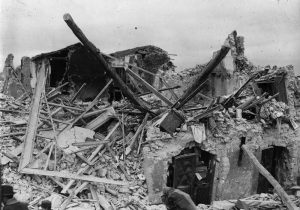 fireplace, while his mother was busy preparing milk and coffee for her two boys. The younger brother would be heading to school after breakfast, but 15 minutes later at 7:50am, the earth started to rumble around them.
fireplace, while his mother was busy preparing milk and coffee for her two boys. The younger brother would be heading to school after breakfast, but 15 minutes later at 7:50am, the earth started to rumble around them.
It didn’t matter that it was 1915, because there are no warning systems for earthquakes in this day and age either. The only thing that might have made a difference would have been buildings that were more earthquake proof. Still, it seems that deaths during earthquakes can happen even if the buildings are earthquake proof. The magnitude 6.7 earthquake destroyed the city. Often we think of an earthquake that brings that much destruction being of far greater magnitude than a 6.7 and maybe the stability of the buildings was the problem. People woke up with debris on them, finding it hard to breathe. Families were ripped apart. Some 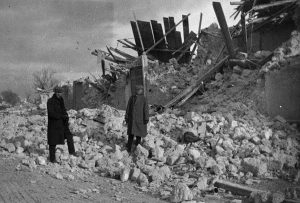 lived and some died. The city and the surrounding area was in mourning.
lived and some died. The city and the surrounding area was in mourning.
When the people came outside, a terrifying sight greeted them. There was a huge greyish cloud that was hanging over the suburbs. The city below the cloud was flattened. The air was filled with the acrid smell of old plaster, and the screams and cries of people who were trapped or had found their loved ones deceased. The city was in despair. Death was everywhere. Beloved, historic buildings were gone…many of which had been thought to be indestructible. The total loss of life in the 1915 Avezzano earthquake was 30,000 people. The financial loss was $60 million.
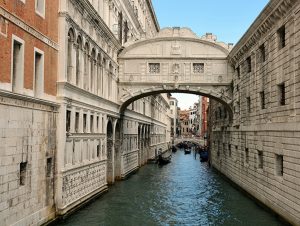 I have never traveled to what is supposed to be one of the most romantic cities in the world…Venice, in Italy, but like most people, I find the city, and especially the buildings to be very beautiful. The bridges in the city are especially beautiful, but some may be very misunderstood…as it turns out. One such “misunderstood” bridge is the Bridge of Sighs. This bridge cannot easily be visited on foot because it is a part of a government prison facility built on the waves near the harbor of the city, but is easily accessible via boats that are constantly flowing under it.
I have never traveled to what is supposed to be one of the most romantic cities in the world…Venice, in Italy, but like most people, I find the city, and especially the buildings to be very beautiful. The bridges in the city are especially beautiful, but some may be very misunderstood…as it turns out. One such “misunderstood” bridge is the Bridge of Sighs. This bridge cannot easily be visited on foot because it is a part of a government prison facility built on the waves near the harbor of the city, but is easily accessible via boats that are constantly flowing under it.
The Bridge of Sighs was built in the 17th century. It is a fully enclosed bridge made of white limestone, and its beauty has caught the attention of many, including the famous English nobleman and poet Lord Byron who told in one of his poems in the 19th century, about the bridge being the last point where condemned prisoners could see the beautiful city of Venice before they were brought to their executioner. That description is very different from the one that is more accepted by tourists, and possibly the tourism industry, who have portrayed it as the sighs of lovers, rather than the sighs of the condemned.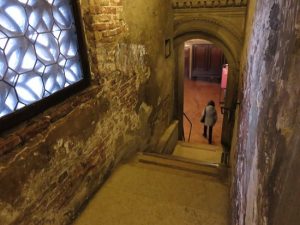
What many tourists, and possible some of the citizens don’t realize is that even centuries after it was built, Bridge of Sighs is still the part of the same prison complex that connects the main building of New Prison (Prigioni Nuove), to the nearby interrogation rooms located in the Doge’s Palace. Of course, the bridge is no longer used in the capacity of transport of maximum security prisoners, but is instead used by small-time offenders who are residing in this low-security prison. The fame of the bridge as the final point of the freedom of the prisoners may have come from the early history of Venice, when its prison was the place of summary executions and where inquisitions were indeed practiced…well before the bridge was ever built.
The Bridge of Sighs was built over the Rio di Palazzo between 1600 and 1603 by the instructions of the architect Antonio Contin, nephew of famous Antonio da Ponte who also designed one of the most popular 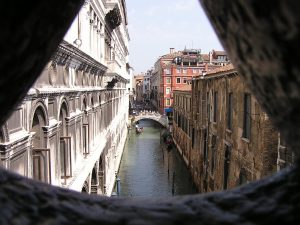 bridges in all of Venice…the Rialto Bridge. Antonio Contin designed this 11 meters long bridge to have a single arch, detailed and stylish outdoor decorations made from Istrian stone, and two windows barred with white stone bars on both sides of the walking chamber. These days, the only way to personally visit the Bridge of Sighs is to take part of “Secret Itinerary” (Itinerari Segreti) tour that is organized by the Doge Palace. The tour is only held between June and September and lasts around 90 minutes, it is done only in Italian and includes visiting of the several famous parts of the prison, such as its antique cells, torture chambers, other rooms, and of course, the Bridge of Sighs, as well. It is much easier to see the famous bridge from the water below, but you would not get to see the inside, of course.
bridges in all of Venice…the Rialto Bridge. Antonio Contin designed this 11 meters long bridge to have a single arch, detailed and stylish outdoor decorations made from Istrian stone, and two windows barred with white stone bars on both sides of the walking chamber. These days, the only way to personally visit the Bridge of Sighs is to take part of “Secret Itinerary” (Itinerari Segreti) tour that is organized by the Doge Palace. The tour is only held between June and September and lasts around 90 minutes, it is done only in Italian and includes visiting of the several famous parts of the prison, such as its antique cells, torture chambers, other rooms, and of course, the Bridge of Sighs, as well. It is much easier to see the famous bridge from the water below, but you would not get to see the inside, of course.
 Every United States Presidential election brings heated debates, and many arguments from both sides of the aisle. I’m sure it is the same in most other nations, who have the opportunity to vote too. Being an unapologetic Conservative, it is my belief that the less the government controls the citizens the better. Socialism and Fascism are both forms of government control, and while some people think these are great, they ultimately find out that what the government gives, the government can also take away. This was what we saw with Adolf Hitler. He came into office as an elected official, and before long, he changed everything for the German people, and in many ways the world, especially the Jewish people, Gypsies, and any other groups he disagreed with. The people were fooled into thinking he was a great man, until it was too late.
Every United States Presidential election brings heated debates, and many arguments from both sides of the aisle. I’m sure it is the same in most other nations, who have the opportunity to vote too. Being an unapologetic Conservative, it is my belief that the less the government controls the citizens the better. Socialism and Fascism are both forms of government control, and while some people think these are great, they ultimately find out that what the government gives, the government can also take away. This was what we saw with Adolf Hitler. He came into office as an elected official, and before long, he changed everything for the German people, and in many ways the world, especially the Jewish people, Gypsies, and any other groups he disagreed with. The people were fooled into thinking he was a great man, until it was too late.
Similar to Adolf Hitler, Italian Fascist leader Benito Mussolini did not become the dictator of a totalitarian regime overnight. Mussolini started out as a schoolteacher and an avowed socialist. After World War I he became a leader of the nascent Fascist movement. Like much of Europe, Italy was in the middle of great social turmoil following World War I. During the turmoil, paramilitary groups and street gangs frequently clashed over their competing ideas for the new political order. A close confidant of Mussolini formed a Fascist paramilitary group, known as the Blackshirts or Squadristi, and because Mussolini was their leader, the gangs found that government fears of a communist revolution allowed them to operate without state intervention. Apparently, the people thought Socialism and Fascism were better than Communism. By 1921, Mussolini had been elected to parliament as the leader of the growing National Fascist Party.
Soon after Mussolini’s election…the party’s Chosen One…armed Blackshirts marched on Rome, demanding that the king install Mussolini as Prime Minister. Why the king allowed this to happen, is beyond me, but in a decision that utterly changed the course of Italian and European history, King Victor Emmanuel III ignored Prime Minister Luigi Facta’s pleas that he declare martial law, leading to Facta’s resignation and Emmanuel’s invitation to Mussolini to form a new government. It was a move that was completely insane. The Fascists and their moderate allies began dismantling Italy’s democratic institutions. Mussolini was proclaimed dictator for a year, like that was going to be all it was, and increasingly merged his party and its paramilitary wing with the state and the official military. He also undertook a program of privatizations and anti-union legislation in order to assure industrialists and aristocrats that fascism would protect them from socialism. Before long, the Italian government didn’t even resemble its former self.
Still, many Fascists felt Mussolini was moving too slowly, so they took matters into their own hands. In 1924, assassins with ties to Mussolini killed socialist leader Giacomo Matteotti, leading most of the parliamentary opposition to boycott Mussolini’s legislature. The Fascists felt that their moment had come. On December 31, 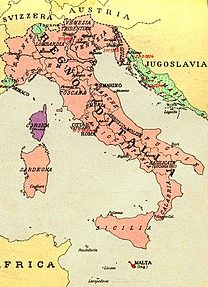 they issued an ultimatum to Mussolini. Three days later on January 3rd, he addressed the remainder of parliament, declaring “I, and I alone, assume the political, moral, and historical responsibility for all that has happened,” obliquely referring to the assassination of Matteotti. In doing this, Mussolini dared prosecutors and the rest of Italy’s democratic institutions, as well as the king, to challenge his authority. It was their last chance, but no one opposed him. Thus, from 1925 onward, Mussolini was able to operate openly as a dictator, styling himself Il Duce (meaning The Leader) and fusing the state and the Fascist Party. For the next two decades, suppression and brutality became the norm, culminating in Mussolini’s alliance with Nazi Germany and World War II. I heard it said that, “You can vote yourself into Socialism, but you will have to shoot your way out of it.” It is a good warning for all of us as we approach the next Presidential election. We have a number of candidates who want Socialism, and it would be a dire mistake to allow that to happen to our free, Capitalist nation. People don’t always understand how important our elections are.
they issued an ultimatum to Mussolini. Three days later on January 3rd, he addressed the remainder of parliament, declaring “I, and I alone, assume the political, moral, and historical responsibility for all that has happened,” obliquely referring to the assassination of Matteotti. In doing this, Mussolini dared prosecutors and the rest of Italy’s democratic institutions, as well as the king, to challenge his authority. It was their last chance, but no one opposed him. Thus, from 1925 onward, Mussolini was able to operate openly as a dictator, styling himself Il Duce (meaning The Leader) and fusing the state and the Fascist Party. For the next two decades, suppression and brutality became the norm, culminating in Mussolini’s alliance with Nazi Germany and World War II. I heard it said that, “You can vote yourself into Socialism, but you will have to shoot your way out of it.” It is a good warning for all of us as we approach the next Presidential election. We have a number of candidates who want Socialism, and it would be a dire mistake to allow that to happen to our free, Capitalist nation. People don’t always understand how important our elections are.
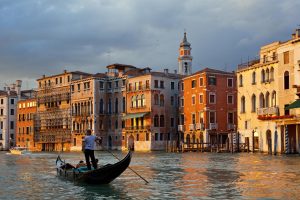 When people think of Venice, Italy, they think of the canals and the boats. I think most of us think the city is pretty much streets of water, and buildings that somehow stand in the water…strong and immovable against the water. Venice is the center of the lagoon of Venice, which extends over a length of 25 miles around the city. While it seems like the city is covered in water, only 11% of the lagoon is permanently covered with water, while the rest of the lagoon is islands or mudflats and marshes (Laguna Morta). The water stays fresh because, seawater from the Adriatic flows into the lagoon through three large passages, Bocca di Lido, Bocca di Malamocco, and Bocca di Chioggia, twice daily. This process provides a natural water exchange. Still, 11% water can sure look like a lot, especially when every touristy picture we see involves the canals and gondolas. So, to think of a situation whereby a flood could become tragic in Venice, is a strange thought for anyone who doesn’t really know Venice…like me.
When people think of Venice, Italy, they think of the canals and the boats. I think most of us think the city is pretty much streets of water, and buildings that somehow stand in the water…strong and immovable against the water. Venice is the center of the lagoon of Venice, which extends over a length of 25 miles around the city. While it seems like the city is covered in water, only 11% of the lagoon is permanently covered with water, while the rest of the lagoon is islands or mudflats and marshes (Laguna Morta). The water stays fresh because, seawater from the Adriatic flows into the lagoon through three large passages, Bocca di Lido, Bocca di Malamocco, and Bocca di Chioggia, twice daily. This process provides a natural water exchange. Still, 11% water can sure look like a lot, especially when every touristy picture we see involves the canals and gondolas. So, to think of a situation whereby a flood could become tragic in Venice, is a strange thought for anyone who doesn’t really know Venice…like me.
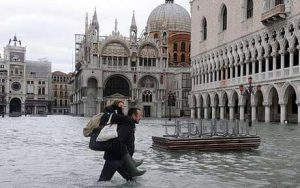
On December 1, 2008, Venice experienced the biggest flood in more than twenty years. The waters rose more than five feet above normal levels. As with any flood, many of Venice’s streets, including Saint Mark’s Square, were submerged. Venice has flooding for about two hundred days every year, and the Venetian authorities were working to complete an underwater dam by 2011. Unfortunately, that fact didn’t help the city in 2008. Even with unusually high tides because of the new moon, residents were not surprised to see the usual low-lying lanes under water. Nevertheless, this day was different. Pretty much the entire city was covered by the lagoon. People stayed inside to wait out the water, only going outside when they were sure the water was definitely going down. The townspeople went outside to take pictures and explore the current townscape…to see what was underwater now. They were quite surprised at the scene before them.
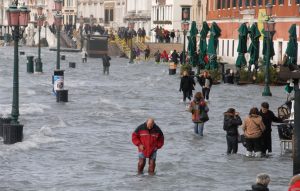
By mid-afternoon, the water had gone down to more normal levels, but all over the world, the papers made it seem like the whole city was sinking. The high tide would come again on December 2nd, but it was nothing like December 1st. Cleanup was still underway on December 2nd, of course, but most businesses were open again. I suppose that if your city spends it’s life in one stage of flood or another, this extra high tide was just something to be taken in stride. Yes, people were surprised at the higher than normal flood waters from the tide, but they weren’t panicked. It was just another day in the life of Venice.
 One of the weapons of naval warfare that all of us know about is the torpedo. Beginning in the 1870’s, torpedoes were rapidly introduced into the navies of many states and soon became the primary weapon of destroyers, submarines, and torpedo boats, cruisers, and ships of the line of that period were also armed with torpedoes. Torpedoes were first used by Russian vessels in the Russo-Turkish War of 1877–78. So torpedoes weren’t new on March 26, 1941, when Italy attacked the British fleet at Souda Bay, Crete, using these new detachable warheads. These torpedoes were different however, and I can only imagine how the men on the deck of the British cruiser must have felt as they watched the streaking torpedo coming toward them.
One of the weapons of naval warfare that all of us know about is the torpedo. Beginning in the 1870’s, torpedoes were rapidly introduced into the navies of many states and soon became the primary weapon of destroyers, submarines, and torpedo boats, cruisers, and ships of the line of that period were also armed with torpedoes. Torpedoes were first used by Russian vessels in the Russo-Turkish War of 1877–78. So torpedoes weren’t new on March 26, 1941, when Italy attacked the British fleet at Souda Bay, Crete, using these new detachable warheads. These torpedoes were different however, and I can only imagine how the men on the deck of the British cruiser must have felt as they watched the streaking torpedo coming toward them.
The difference between the torpedoes of old, and these new torpedoes, was that these were manned torpedoes. No, there weren’t men on the torpedo known as the Chariot.” Nevertheless it was unique. Primarily used to attack enemy ships still in harbor, the Chariots needed “pilots” to “drive” them to their targets…basically a guided missile system…but in a very primitive form. Sitting astride the torpedo on a vehicle that  would transport them both, the pilot would guide the missile as close to the target as possible, then ride the vehicle back, usually to a submarine. The Chariot was an enormous advantage, because before its development, the closest weapon to the Chariot was the Japanese Kaiten–a human torpedo, or suicide bomb, which had obvious drawbacks. I can’t imagine being ordered to pilot that one, but then the Japanese were known for their suicide attacks.
would transport them both, the pilot would guide the missile as close to the target as possible, then ride the vehicle back, usually to a submarine. The Chariot was an enormous advantage, because before its development, the closest weapon to the Chariot was the Japanese Kaiten–a human torpedo, or suicide bomb, which had obvious drawbacks. I can’t imagine being ordered to pilot that one, but then the Japanese were known for their suicide attacks.
The Italian attack was just the first successful use of the Chariot, or any other manned torpedo, although they referred to their version as Maiali, or “Pigs.” On that March day, six Italian motorboats, commanded by Italian naval commander Lieutenant Luigi Faggioni, entered Souda Bay in Crete and planted their Maiali along a British convoy in harbor there. The British cruiser, York was so badly damaged that it had to be beached. The manned torpedo system proved to be the most effective weapon in the Italian naval arsenal, and it was used successfully against the British again in December 1941 at Alexandria, Egypt. Italian torpedoes sank the British battleships Queen Elizabeth and Valiant, as well as one tanker. They were also used against merchant ships at 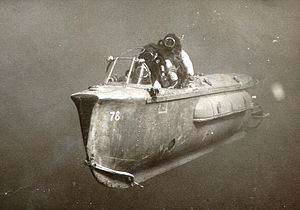 Gibraltar and elsewhere.
Gibraltar and elsewhere.
Deeply angered, the British avenged themselves against the Italians, by sinking the new Italian cruiser Ulpio Traiano in the port of Palermo, Sicily, in early January 1943. An 8,500-ton ocean liner was also damaged in the same attack. After the Italian surrender, the use of the manned torpedo continued to be used by both the British, and later the Germans. In fact, Germany succeeded in sinking two British minesweepers off Normandy Beach in July 1944, using their “Neger” torpedoes. These would be the best torpedo, until the guidance systems could be invented.
 Earthquakes can happen anywhere, but there are areas that are more prone to earthquakes than other areas. When we think about that, we think of Alaska, California, or Japan, all of which experience daily earthquakes. Of course, there are many other places that get a lot of earthquakes. One such place is in Italy. The area around Sicily and Calabria are known as la terra ballerina, “the dancing land,” for the periodic seismic activity that strikes the region. I would have thought that with 12,000 earthquakes a year in Alaska, or 10,000 earthquakes a year in California, or 1,500 earthquakes in Japan, that any of these places would be called “the dancing land” before the area of Sicily and Calabria, which doesn’t have nearly as many.
Earthquakes can happen anywhere, but there are areas that are more prone to earthquakes than other areas. When we think about that, we think of Alaska, California, or Japan, all of which experience daily earthquakes. Of course, there are many other places that get a lot of earthquakes. One such place is in Italy. The area around Sicily and Calabria are known as la terra ballerina, “the dancing land,” for the periodic seismic activity that strikes the region. I would have thought that with 12,000 earthquakes a year in Alaska, or 10,000 earthquakes a year in California, or 1,500 earthquakes in Japan, that any of these places would be called “the dancing land” before the area of Sicily and Calabria, which doesn’t have nearly as many.
Nevertheless, the name was given and it stuck. While it may not have as many, the ones that hit there seem to be especially devastating. In 1693, 60,000 people were killed in southern Sicily by an earthquake, and in 1783 most of the Tyrrenian coast of Calabria was leveled by a massive earthquake that 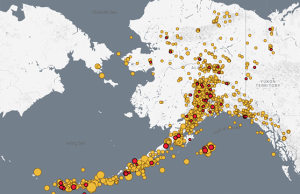 killed 50,000. The quake of 1908 was particularly costly in terms of human life because it struck at at dawn, catching most people at home in bed rather than in the relative safety of the streets or fields. The December 28, 1908 earthquake which struck at 5:20am was the most destructive earthquake in recorded European history strikes the Straits of Messina in southern Italy. The cities of Messina in Sicily and Reggio di Calabria on the Italian mainland were leveled by the devastating quake. The earthquake and tsunami it caused killed an estimated 100,000 people. The main shock registered an estimated 7.5 magnitude on the Richter scale. It caused a devastating tsunami with 40-foot waves that washed over coastal towns and cities. The two major cities on either side of the Messina Straits–Messina and Reggio di Calabria, had about 90 percent of their buildings destroyed. The quake cut telegraph lines and damaged railway lines, seriously slowing down the relief efforts. To make matters worse, many of the remaining buildings were destroyed by hundreds of smaller
killed 50,000. The quake of 1908 was particularly costly in terms of human life because it struck at at dawn, catching most people at home in bed rather than in the relative safety of the streets or fields. The December 28, 1908 earthquake which struck at 5:20am was the most destructive earthquake in recorded European history strikes the Straits of Messina in southern Italy. The cities of Messina in Sicily and Reggio di Calabria on the Italian mainland were leveled by the devastating quake. The earthquake and tsunami it caused killed an estimated 100,000 people. The main shock registered an estimated 7.5 magnitude on the Richter scale. It caused a devastating tsunami with 40-foot waves that washed over coastal towns and cities. The two major cities on either side of the Messina Straits–Messina and Reggio di Calabria, had about 90 percent of their buildings destroyed. The quake cut telegraph lines and damaged railway lines, seriously slowing down the relief efforts. To make matters worse, many of the remaining buildings were destroyed by hundreds of smaller 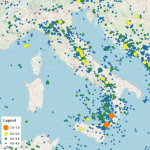 tremors over subsequent days. These tremors injured or killed rescuers. On December 30, King Victor Emmanuel III arrived aboard the battleship Napoli to inspect the devastation.
tremors over subsequent days. These tremors injured or killed rescuers. On December 30, King Victor Emmanuel III arrived aboard the battleship Napoli to inspect the devastation.
To make matters worse, a steady rain fell on the ruined cities, forcing the dazed and injured survivors, clad only in their nightclothes, to take shelter in caves, grottoes, and impromptu shacks built out of materials salvaged from the collapsed buildings. Veteran sailors could barely recognize the shoreline because long stretches of the coast had sunk several feet into the Messina Strait. The devastation was horrific. After all that, I can see why it is called la terra ballerina, “the dancing land.”
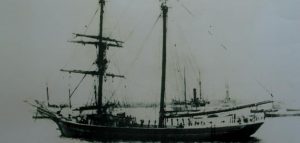 The Mary Celeste began its fateful voyage on November 7, 1872. She set sail with seven crewmen and Captain Benjamin Spooner Briggs, his wife, Sarah, and the couple’s 2-year-old daughter, Sophia. The 282 ton brigantine battled heavy weather for two weeks to reach the Azores. It was there that the ship logged its last entry at 5am on November 25, 1872. The rest of the story of the Mary Celeste remains a mystery, although the ship was found in good shape and completely sea-worthy.
The Mary Celeste began its fateful voyage on November 7, 1872. She set sail with seven crewmen and Captain Benjamin Spooner Briggs, his wife, Sarah, and the couple’s 2-year-old daughter, Sophia. The 282 ton brigantine battled heavy weather for two weeks to reach the Azores. It was there that the ship logged its last entry at 5am on November 25, 1872. The rest of the story of the Mary Celeste remains a mystery, although the ship was found in good shape and completely sea-worthy.
I find it strange to think that in the middle of the ocean, something can happen with little or no warning, that either takes the lives of people onboard a ship, or results in their disappearance. I understand mutiny, but then that does not leave a ship abandoned. So if not mutiny, how is it that the occupants of the ship did not see the other ship approaching? I know that pirates often overtook the ships, but the occupants of the ship were usually killed in a bloody battle. The people onboard did not just disappear. Nevertheless, something happened on the Mary Celeste between that final message on November 25, 1872 and December 5th, 1872, when she was spotted drifting along, in the Atlantic Ocean…empty.
The British brig Dei Gratia was about 400 miles east of the Azores on December 5, 1872, when crew members spotted a ship adrift in the choppy seas. Captain David Morehouse was shocked to discover that the unguided vessel was the Mary Celeste. It had left New York City eight days before him and should have already arrived in Genoa, Italy. He changed course to offer help. Morehouse sent a boarding party to the ship. When they went below decks, they discovered that the ship’s charts had been tossed about, and the crewmen’s belongings were still in their quarters. The ship’s only lifeboat was missing, and one of its two pumps had been disassembled. Three and a half feet of water was sloshing in the ship’s bottom, but the cargo of 1,701 barrels of industrial alcohol was largely intact. There was a six month supply of food and water…and no one to use it. So, the mystery began, and it has endured as one of the most durable mysteries in nautical history…What happened to the ten people who had sailed aboard the Mary Celeste? Over the many years since the discovery, a lack of hard evidence has only created more speculation as to what might have taken place. Theories have ranged from mutiny to pirates to sea monsters to killer waterspouts….some of which are completely ridiculous, but in the absence of evidence, people will speculate.
Arthur Conan Doyle’s 1884 short story based on the case posited a capture by a vengeful ex-slave, a 1935 movie featured Bela Lugosi as a homicidal sailor. Now, a new investigation, drawing on modern maritime technology and newly discovered documents, has pieced together the most likely scenario…which had nothing to do with Bela Lugosi. In fact, while it is unproven, it is thought that something a simple as coal dust could be the culprit. The idea is that the coal dust from a prior voyage filtered into the ships pumps, causing them to quit working. Then, it is thought that the captain, fearing that the ship would sink, ordered the passengers to abandon ship…well within sight of land at Azores. Anne MacGregor, the documentarian who launched the investigation and wrote, directed and produced The True Story of the ‘Mary Celeste,’ partly with funding from Smithsonian Networks. MacGregor learned that on its previous voyage, the Mary Celeste had carried coal and that the ship had recently been extensively refitted. Coal dust and construction debris could have fouled the ship’s pumps, which would explain the disassembled pump found on the Mary Celeste. With the pump inoperative, Briggs would not have known how much seawater was in his ship’s hull, which was too fully packed for him to measure visually. Of course, this is still speculation, because the ten people onboard were never heard from again, so the mystery continues.
to do with Bela Lugosi. In fact, while it is unproven, it is thought that something a simple as coal dust could be the culprit. The idea is that the coal dust from a prior voyage filtered into the ships pumps, causing them to quit working. Then, it is thought that the captain, fearing that the ship would sink, ordered the passengers to abandon ship…well within sight of land at Azores. Anne MacGregor, the documentarian who launched the investigation and wrote, directed and produced The True Story of the ‘Mary Celeste,’ partly with funding from Smithsonian Networks. MacGregor learned that on its previous voyage, the Mary Celeste had carried coal and that the ship had recently been extensively refitted. Coal dust and construction debris could have fouled the ship’s pumps, which would explain the disassembled pump found on the Mary Celeste. With the pump inoperative, Briggs would not have known how much seawater was in his ship’s hull, which was too fully packed for him to measure visually. Of course, this is still speculation, because the ten people onboard were never heard from again, so the mystery continues.
 World wars are a complicated matter. There are multiple enemies, multiple allies, and the lines are not necessarily very clear. The one thing that always seems to be a constant, however, is territory. Imperialism…when a country takes over new lands or countries and makes them subject to their rule, played a big roll in World War I, as did industrialism. By 1900, any territorial gain by one power meant the loss of territory by another, and for Britain, the strongest of all the empires, that was a problem. Britain’s colonial territory was over 100 times the size of its own territory at home, thus giving rise to the phrase “the sun never sets on the British empire.” At this same time, France had control of large areas of Africa. With the rise of industrialism countries needed new markets. The amount of lands owned by Britain and France increased the rivalry with Germany who had entered the scramble to acquire colonies late and only had small areas of Africa.
World wars are a complicated matter. There are multiple enemies, multiple allies, and the lines are not necessarily very clear. The one thing that always seems to be a constant, however, is territory. Imperialism…when a country takes over new lands or countries and makes them subject to their rule, played a big roll in World War I, as did industrialism. By 1900, any territorial gain by one power meant the loss of territory by another, and for Britain, the strongest of all the empires, that was a problem. Britain’s colonial territory was over 100 times the size of its own territory at home, thus giving rise to the phrase “the sun never sets on the British empire.” At this same time, France had control of large areas of Africa. With the rise of industrialism countries needed new markets. The amount of lands owned by Britain and France increased the rivalry with Germany who had entered the scramble to acquire colonies late and only had small areas of Africa.
During this time Germany became concerned that Russia might try to take over their nation, so they signed a  treaty with Austria-Hungary to protect each other from Russia. The Dual Alliance was created by treaty on October 7, 1879 as part of Bismarck’s system of alliances to prevent or limit war. The two powers promised each other support in case of attack by Russia. Also, each state promised benevolent neutrality to the other if one of them was attacked by another European power, most likely France. Germany’s Otto von Bismarck saw the alliance as a way to prevent the isolation of Germany and to preserve peace, as Russia would not wage war against both empires. Then in 1881, Austria-Hungary made an alliance with Serbia to stop Russia from gaining control of Serbia. Before long alliances were popping up everywhere. Germany and Austria-Hungary made an alliance with Italy in 1882 that was dubbed The Triple Alliance to stop Italy from taking sides with Russia. Then in 1894, Russia formed an alliance with France called the Franco-Russian Alliance, to protect Russia against Germany and Austria-Hungary.
treaty with Austria-Hungary to protect each other from Russia. The Dual Alliance was created by treaty on October 7, 1879 as part of Bismarck’s system of alliances to prevent or limit war. The two powers promised each other support in case of attack by Russia. Also, each state promised benevolent neutrality to the other if one of them was attacked by another European power, most likely France. Germany’s Otto von Bismarck saw the alliance as a way to prevent the isolation of Germany and to preserve peace, as Russia would not wage war against both empires. Then in 1881, Austria-Hungary made an alliance with Serbia to stop Russia from gaining control of Serbia. Before long alliances were popping up everywhere. Germany and Austria-Hungary made an alliance with Italy in 1882 that was dubbed The Triple Alliance to stop Italy from taking sides with Russia. Then in 1894, Russia formed an alliance with France called the Franco-Russian Alliance, to protect Russia against Germany and Austria-Hungary.
Now at this point, I’m sure you feel as confused about all this as I did. To me, it seems like it would be very difficult to know who the enemy really was, and even if you knew, it was subject to change, depending on who they formed an alliance with. That is also why I was wondering why on June 16, 1918, the Battle of the Piave River was raging on the Italian front. Russia had bowed out of the war effort in early 1918, and Germany began  to pressure its ally, Austria-Hungary, to devote more resources to combating Italy. Wait…I thought Italy was their ally…apparently not so much. Specifically, the Germans wanted a major new offensive along the Piave River, located just a few kilometers from such important Italian urban centers as Venice, Padua and Verona. In addition to striking on the heels of Russia’s withdrawal, the offensive was intended as a follow-up to the spectacular success of the German-aided operations at Caporetto in the autumn of 1917. Wars really seem to be quite senseless, but when Imperialistic nations try to expand their territories, I guess, alliances can be made and broken quite easily.
to pressure its ally, Austria-Hungary, to devote more resources to combating Italy. Wait…I thought Italy was their ally…apparently not so much. Specifically, the Germans wanted a major new offensive along the Piave River, located just a few kilometers from such important Italian urban centers as Venice, Padua and Verona. In addition to striking on the heels of Russia’s withdrawal, the offensive was intended as a follow-up to the spectacular success of the German-aided operations at Caporetto in the autumn of 1917. Wars really seem to be quite senseless, but when Imperialistic nations try to expand their territories, I guess, alliances can be made and broken quite easily.
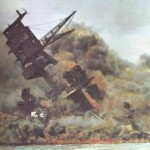
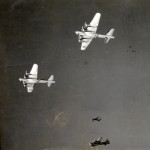 World War II had been raging since September 1, 1939. It was without doubt the most destructive war in history. Some say it was simply a continuation of World War I, that had ended in 1918. Others will blame the 1931 Japanese seizure of Manchuria from China, or Italy’s invasion and defeat of Ethiopia in 1935, or Adolf Hitler’s re-militarization of Germany in 1936, or the Spanish Civil War 1936 to 1939, or Germany’s occupation of Czechoslovakia in 1938 as possible beginnings. But, the two dates most often mentioned as “the beginning of World War II” are July 7, 1937, when the “Marco Polo Bridge Incident” led to war between Japan and China, and September 1, 1939, when Germany invaded Poland, which led Britain and France to declare war on Hitler’s Nazi state in retaliation. To me it would seem that the tensions that had begun before World War I, simply never went away. It would seem that there were many world leaders who were power hungry, and greedy for the lands that belonged to their neighbors. And when you look at the Middle East today, maybe not much has really changed.
World War II had been raging since September 1, 1939. It was without doubt the most destructive war in history. Some say it was simply a continuation of World War I, that had ended in 1918. Others will blame the 1931 Japanese seizure of Manchuria from China, or Italy’s invasion and defeat of Ethiopia in 1935, or Adolf Hitler’s re-militarization of Germany in 1936, or the Spanish Civil War 1936 to 1939, or Germany’s occupation of Czechoslovakia in 1938 as possible beginnings. But, the two dates most often mentioned as “the beginning of World War II” are July 7, 1937, when the “Marco Polo Bridge Incident” led to war between Japan and China, and September 1, 1939, when Germany invaded Poland, which led Britain and France to declare war on Hitler’s Nazi state in retaliation. To me it would seem that the tensions that had begun before World War I, simply never went away. It would seem that there were many world leaders who were power hungry, and greedy for the lands that belonged to their neighbors. And when you look at the Middle East today, maybe not much has really changed.
Wherever you place the beginning of World War II, you would agree that while the Japanese and the Germans may not have been war weary, the rest of the world really was. Before the Japanese attacked Pearl Harbor on December 7, 1941, the United States had somehow managed to stay out of the conflict. Whether that was right or wrong is a matter of opinion too. Nevertheless, when the Japanese brought the war to our front door, the United States answered with a vengeance. I’m sure the allies were glad to have the reinforcements, but also wondered why it had taken so long for us to get involved. Sometimes, I have wondered that myself, about that and other wars that we have come into just a little bit late in the game.
That said, we got into the war, and I believe that the extra military might that the United States brought to the Allied Forces was the tipping point in the war, because a war that had officially raged since September 1, 1939, was brought to an end on September 2, 1945, when Victory over Japan was celebrated in the United States. Japanese troops finally surrendered to Americans on the Caroline, Mariana, and Palau islands. Representatives of their emperor and prime minister were preparing to formalize their declaration of defeat. In Tokyo Bay, aboard the Navy battleship USS Missouri, Japanese foreign minister, Mamoru Shigemitsu and chief of staff of the Japanese army, Yoshijiro Umezu, signed the “instrument of surrender.” General Douglas MacArthur, commander of the US Army forces in the Pacific, and Admiral Chester Nimitz, commander of the US Pacific Fleet were there to represent the Allied victors.
After the surrender, Mamoru Shigemitsu was found guilty of war crimes. He was sentenced to seven years in prison. Oddly, it was he who had fought for concessions on the Japanese side in an attempt to secure an early peace. He was paroled in 1950 and went on to become chairman of Japan’s Progressive Party. General 
 MacArthur would come up against him again when he was named commander in chief of the United Nations forces in Korea in 1950. For some people, it would seem, that one defeat simply isn’t enough, but that is another story. Today is VJ Day…Victory over Japan Day. It may not be a day that we remember as well as we do D Day, which simply stands for the day designated to storm the beaches at Normandy, or the attack on Pearl Harbor, but VJ Day is in reality as important a day as those others too, because it was the day that ended the world’s worst, and most destructive war.
MacArthur would come up against him again when he was named commander in chief of the United Nations forces in Korea in 1950. For some people, it would seem, that one defeat simply isn’t enough, but that is another story. Today is VJ Day…Victory over Japan Day. It may not be a day that we remember as well as we do D Day, which simply stands for the day designated to storm the beaches at Normandy, or the attack on Pearl Harbor, but VJ Day is in reality as important a day as those others too, because it was the day that ended the world’s worst, and most destructive war.

